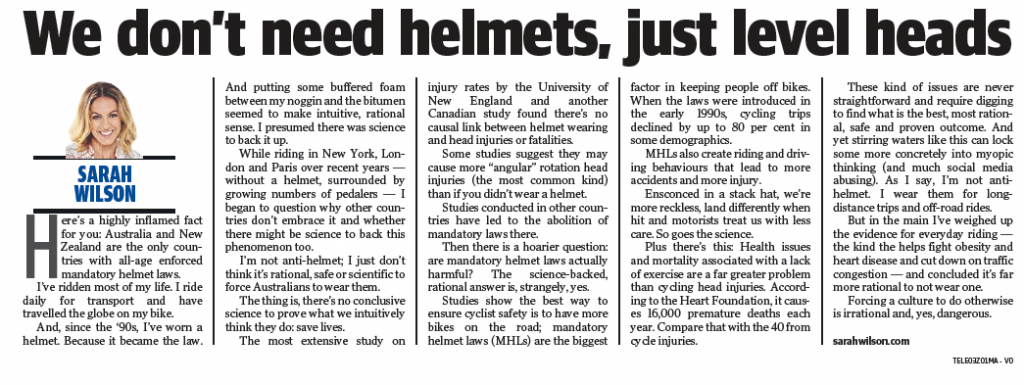Some time back I mentioned I don’t wear a helmet all the time. And that I don’t support mandatory helmet laws (MHLs). Over the years these admissions have triggered heated (and, sadly, misinformed) feedback. I wrote this post to explain why I arrived at my conclusions. It’s not a vain preference; my stance is based on sound science and I encourage anyone disturbed by my position, particularly those who get a little abusive in their response, to read the below, do their own research also, and to feel free to point me to legitimate and non-vested science I might have missed.
Update: I have, yes, updated this post March 2019.
There are two separate issues when discussing this topic
…and they shouldn’t be conflated.
The first: Do helmets work?
The second: Do mandatory helmet laws work?
I’ll stress, before you read on: I’m not anti-helmet. I’m against the the mandatory helmet laws here in Australia. In fact, my interest in the topic emerged when I started questioning why Australia and New Zealand are the only countries in the world with all-age enforced MHLs. It seemed odd.
Update: According to Freestyle Cyclists, while New Zealand still has MHLs, the level of enforcement has dropped dramatically – to neglible levels – over the past five years, with national road policing manager, Inspector Peter McKennie saying their focus is on “people not wearing seatbelts, driving while impaired by alcohol, drugs or fatigue”.
Thus, Australia remains the only country in the world bogged down in this mess.
Does the rest of the world not care about the collective noggins of its citizens? Or do they not have them for good reason? Turns out it’s the latter.
If you’d like to read the column I wrote for News Ltd on this matter click here. Note: the headline isn’t mine.
Update: The few other jurisdictions that did have partially enforced laws (most didn’t issue fines) have since repealed or reformed them, including Mexico, Israel, Bosnia-Hertzegovina and Malta.

There’s no conclusive proof helmets save lives or limit injuries. In fact, the opposite.
The “science” on whether helmets actually protect us on an individual basis is very inconclusive and no randomised controlled trials have been done on the safety of bike helmets. The trials that have been done, however, point to the fact they don’t actually save lives. This Canadian one, published in BMJ, is a case in point. Which is part of the reason why the rest of the world don’t have MHLs (although only part of the reason; the main one is explained below). There are so many variables entailed in how this can possibly be so:
Helmets actually cause head rotation in a large number of bike accidents.
Helmets have been shown to prevent injury from “linear speeding”. But the majority of head injuries from bike accidents occur from “angular” accidents caused when the head is rotated. Hmmm. Bill Curnow, President of the Cyclists Rights Action Group in Canberra, reviewed the scientific literature for a 2008 book, Transport Accident Analysis and Prevention. He writes, “Scientific circles had ‘widely discredited’ the theory that linear acceleration is the main cause of brain injury, yet helmet makers had made a huge investment in this theory and designed their helmets accordingly, while ignoring the role of angular acceleration in causing brain injury, due to rotation of the head.
It gets worse.
Soft-shell helmets were approved a while back; they’re more comfortable and airy than previous ones. This is what most people wear these days. But wait for this:
They were approved despite advise that they caused increased rotational forces.
These helmets are tested to impact speeds of only 19.5km/h (the speed of impact of being dropped 1.5m) and to pass they only have to not shatter. If a helmet shatters, of course, it’s failed. As Dr Paul Martin at St Vincents, Sydney: “A helmet smashing into pieces is actually a sign of the helmet failing to work as it should. The foam needs to compress significantly if any forces are to be attenuated. If it cracks or breaks before the foam compresses then it has done nothing to help you. The documents can be read in full at your local state library (the main one is AS/NZS2063 and the testing documents are AS/NZS2512).
The new helmet standards mandate that the straps now have to stretch to allow the helmet to come off after the ‘initial impact’. As Dr Paul says, “How does the helmet ‘know’ if the initial impact is going to be the ‘big one’?”
Helmets that don’t comply with the updated standard are illegal to sell but not illegal to wear (if you can follow that logic) I.e. You might have a helmet that you bought before the updated helmet laws, but you can still wear it… which makes a law forcing people to wear such helmets just a bit ridiculous).
A bicycle helmet will not protect your face…nor your cervical spine.
Which is kind of important.
Helmets make riders – and drivers – less cautious..
…therefore more likely to crash. This is a thread that comes up in a lot of studies – helmet-free riders are defensive riders. Similarly, studies show “risk compensation” kicks in for bike riders. That is, Helmet riders can be more complacent and take more risks. Ditto drivers. One study shows drivers are more considerate of riders without helmets.
